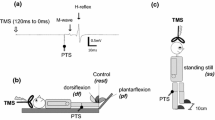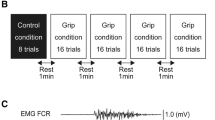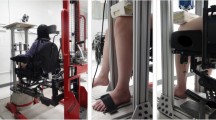Abstract
Transcutaneous spinal stimulation is a noninvasive method that can activate dorsal and/or ventral roots depending on the location and intensity of stimulation. Reflex root-evoked potentials (REPs) were studied in muscles that traditionally evoke large (soleus) and small H-reflexes (tibialis anterior), as well as muscles where H-reflexes are difficult to study (hamstrings). This study characterizes the interaction of the REP and the motor-evoked potential (MEP). Transcranial magnetic stimulation (TMS) delivered 11–25 ms before spinal stimulation resulted in more than linear summation of the two responses. Because of overlap, the modulation was quantified after subtracting the contribution of the conditioning MEP or REP. At rest, the mean-rectified soleus response was facilitated by up to ~250 μV (21-times the MEP or 161 % of the REP). The increases were more reliable during a voluntary contraction (up to ~300 μV, 517 % of the MEP or 181 % of the REP). At the 13-ms interval, the mean-rectified response in the pre-contracted hamstrings was increased by 227 % of the MEP or 300 % of the REP. In some subjects, TMS could also eliminate the post-activation depression produced using two spinal stimuli, confirming that the interaction can extend to presynaptic spinal neurons. The spatiotemporal facilitation in tibialis anterior was not significant. However, the large MEP was facilitated when the spinal stimulus preceded TMS by 100–150 ms, presumably because of rebound excitation. These strong interactions may be important for inducing motor plasticity and improved training procedures for recovery after neurological damage.





Similar content being viewed by others
References
Aoki M, Yamamura T (1980) Postinhibitory rebound facilitation of the extension reflex in the high spinal cat. Jpn J Physiol 30:465–471
Cortes M, Thickbroom GW, Valls-Sole J, Pascual-Leone A, Edwards DJ (2011) Spinal associative stimulation: a non-invasive stimulation paradigm to modulate spinal excitability. Clin Neurophysiol 122:2254–2259
Courtine G, Harkema SJ, Dy CJ, Gerasimenko YP, Dyhre-Poulsen P (2007) Modulation of multisegmental monosynaptic responses in a variety of leg muscles during walking and running in humans. J Physiol 582:1125–1139
Darabant L, Krenn M, Minassian K, Cretu M, Mayr W, Ciupa RV (2011) Double stimuli paradigms should be careful interpreted when applying lumbar magnetic stimulation. IFMBE Proc 36:168–171
Deuschl G, Michels R, Berardelli A, Schenck E, Inghilleri M, Lucking CH (1991) Effects of electric and magnetic transcranial stimulation on long latency reflexes. Exp Brain Res Experimentelle Hirnforschung Experimentation Cerebrale 83:403–410
Di Lazzaro V, Ziemann U, Lemon R (2008) State of the art: physiology of transcranial motor cortex stimulation. Brain Stimul 1:345–362
Dimitrijevic MM, Dimitrijevic MR, Illis LS, Nakajima K, Sharkey PC, Sherwood AM (1986) Spinal cord stimulation for the control of spasticity in patients with chronic spinal cord injury: I. Clinical observations. Cent Nerv Syst Trauma 3:129–144
Gassel MM, Ott KH (1970) Local sign and late effects on motoneuron excitability of cutaneous stimulation in man. Brain 93:95–106
Guzman-Lopez J, Costa J, Selvi A, Barraza G, Casanova-Molla J, Valls-Sole J (2012) The effects of transcranial magnetic stimulation on vibratory-induced presynaptic inhibition of the soleus H reflex. Exp Brain Res 220:223–230
Harkema S, Gerasimenko Y, Hodes J, Burdick J, Angeli C, Chen Y, Ferreira C, Willhite A, Rejc E, Grossman RG, Edgerton VR (2011) Effect of epidural stimulation of the lumbosacral spinal cord on voluntary movement, standing, and assisted stepping after motor complete paraplegia: a case study. Lancet 377:1938–1947
Herman R, He J, D’Luzansky S, Willis W, Dilli S (2002) Spinal cord stimulation facilitates functional walking in a chronic, incomplete spinal cord injured. Spinal Cord 40:65–68
Hofstoetter US, McKay WB, Tansey K, Mayr W, Kern H, Minassian K (2013) Modification of spasticity by transcutaneous spinal cord stimulation in incomplete spinal cord injured individuals. J Spinal Cord Med. doi:10.1179/2045772313Y.0000000149
Hultborn H, Illert M, Nielsen J, Paul A, Ballegaard M, Wiese H (1996) On the mechanism of the post-activation depression of the H-reflex in human subjects. Exp Brain Res 108:450–462
Iles JF (1996) Evidence for cutaneous and corticospinal modulation of presynaptic inhibition of Ia afferents from the human lower limb. J Physiol 491(Pt 1):197–207
Iles JF, Pisini JV (1992) Cortical modulation of transmission in spinal reflex pathways of man. J Physiol 455:425–446
Journee HL, Polak HE, de Kleuver M, Langeloo DD, Postma AA (2004) Improved neuromonitoring during spinal surgery using double-train transcranial electrical stimulation. Med Biol Eng Comput 42:110–113
Journee HL, Polak HE, De Kleuver M (2007) Conditioning stimulation techniques for enhancement of transcranially elicited evoked motor responses. Neurophysiol Clin 37:423–430
Knash ME, Kido A, Gorassini M, Chan KM, Stein RB (2003) Electrical stimulation of the human common peroneal nerve elicits lasting facilitation of cortical motor-evoked potentials. Exp Brain Res 153:366–377
Maertens de Noordhout A, Rothwell JC, Thompson PD, Day BL, Marsden CD (1988) Percutaneous electrical stimulation of lumbosacral roots in man. J Neurol Neurosurg Psychiatry 51:174–181
Matthews PB (1996) Relationship of firing intervals of human motor units to the trajectory of post-spike after-hyperpolarization and synaptic noise. J Physiol 492(Pt 2):597–628
McPhedran AM, Wuerker RB, Henneman E (1965) Properties of motor units in a homogeneous red muscle (Soleus) of the cat. J Neurophysiol 28:71–84
Meunier S (1999) Modulation by corticospinal volleys of presynaptic inhibition to Ia afferents in man. J Physiol Paris 93:387–394
Minassian K, Jilge B, Rattay F, Pinter MM, Binder H, Gerstenbrand F, Dimitrijevic MR (2004) Stepping-like movements in humans with complete spinal cord injury induced by epidural stimulation of the lumbar cord: electromyographic study of compound muscle action potentials. Spinal Cord 42:401–416
Minassian K, Persy I, Rattay F, Dimitrijevic MR, Hofer C, Kern H (2007) Posterior root-muscle reflexes elicited by transcutaneous stimulation of the human lumbosacral cord. Muscle Nerve 35:327–336
Moshonkina TR, Makarovski AN, Bogacheva IN, Scherbakova NA, Savohin AA, Gerasimenko YP (2012) Effects of spinal cord electrical stimulation in patients with vertebrospinal pathology. Bull Exp Biol Med 153:16–20
Nielsen J, Petersen N, Deuschl G, Ballegaard M (1993) Task-related changes in the effect of magnetic brain stimulation on spinal neurones in man. J Physiol 471:223–243
Nielsen JF, Sinkjaer T, Jakobsen J (1996) Treatment of spasticity with repetitive magnetic stimulation; a double-blind placebo-controlled study. Mult Scler 2:227–232
Pereon Y, Guiheneuc P (1995) Late facilitations of motor evoked potentials by contralateral mixed nerve stimulation. Electroencephalogr Clin Neurophysiol 97:126–130
Poon DE, Roy FD, Gorassini MA, Stein RB (2008) Interaction of paired cortical and peripheral nerve stimulation on human motor neurons. Exp Brain Res 188:13–21
Roy FD, Gorassini MA (2008) Peripheral sensory activation of cortical circuits in the leg motor cortex of man. J Physiol 586:4091–4105
Roy FD, Norton JA, Gorassini MA (2007) Role of sustained excitability of the leg motor cortex after transcranial magnetic stimulation in associative plasticity. J Neurophysiol 98:657–667
Roy FD, Yang JF, Gorassini MA (2010) Afferent regulation of leg motor cortex excitability after incomplete spinal cord injury. J Neurophysiol 103:2222–2233
Roy FD, Gibson G, Stein RB (2012a) Effect of percutaneous stimulation at different spinal levels on the activation of sensory and motor roots. Exp Brain Res 223:281–289
Roy FD, Gibson G, Stein RB (2012b) Interaction of corticospinal and dorsal root inputs to human leg muscles. In: International functional electrical stimulation society. Banff, AB, Canada
Stein RB, Thompson AK (2006) Muscle reflexes in motion: how, what, and why? Exerc Sport Sci Rev 34(4):145–153
Stein RB, Everaert DG, Roy FD, Chong S, Soleimani M (2013) Facilitation of corticospinal connections in able-bodied people and people with central nervous system disorders using eight interventions. J Clin Neurophysiol 30:66–78
Taylor JL, Martin PG (2009) Voluntary motor output is altered by spike-timing-dependent changes in the human corticospinal pathway. J Neurosci 29:11708–11716
Troni W, Di Sapio A, Berra E, Duca S, Merola A, Sperli F, Bertolotto A (2011) A methodological reappraisal of non invasive high voltage electrical stimulation of lumbosacral nerve roots. Clin Neurophysiol 122:2071–2080
Valls-Sole J, Alvarez R, Tolosa ES (1994) Vibration-induced presynaptic inhibition of the soleus H reflex is temporarily reduced by cortical magnetic stimulation in human subjects. Neurosci Lett 170:149–152
van den Brand R, Heutschi J, Barraud Q, DiGiovanna J, Bartholdi K, Huerlimann M, Friedli L, Vollenweider I, Moraud EM, Duis S, Dominici N, Micera S, Musienko P, Courtine G (2012) Restoring voluntary control of locomotion after paralyzing spinal cord injury. Science 336:1182–1185
Windhorst U (1996) On the role of recurrent inhibitory feedback in motor control. Prog Neurobiol 49:517–587
Acknowledgments
This research was supported in part by the Canadian Institutes for Health Research. We are grateful to Dr. Monica Gorassini for the loan of some equipment and for insightful comments on the manuscript.
Author information
Authors and Affiliations
Corresponding author
Rights and permissions
About this article
Cite this article
Roy, F.D., Bosgra, D. & Stein, R.B. Interaction of transcutaneous spinal stimulation and transcranial magnetic stimulation in human leg muscles. Exp Brain Res 232, 1717–1728 (2014). https://doi.org/10.1007/s00221-014-3864-6
Received:
Accepted:
Published:
Issue Date:
DOI: https://doi.org/10.1007/s00221-014-3864-6




